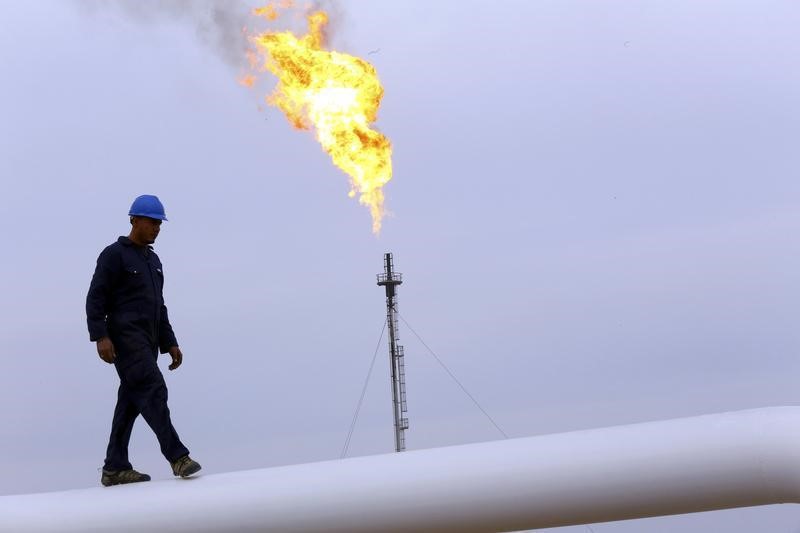Two National Guard members shot near White House
Investing.com -- Crude prices jumped on the last trading day of April to return to the black after spending the better part of the last 10 months in the red — an unexpectedly poor stretch that confounded oil bulls who had come to regard $100 a barrel as a given in a market long on OPEC hype and short on delivery.
With an hour to Friday’s settlement, New York-traded West Texas Intermediate, or WTI, was up $1.69, or 2.3%, on the day to trade at $76.45 per barrel. For the week, the U.S. crude benchmark remained in the red, with a loss of 1.5%.
For all of April though, WTI showed a return of 0.9%. It was the first positive monthly closing for WTI after five previous months of losses. Earlier to that, WTI was only in the green for one month — October — after spending another four months in the red.
London-traded Brent, the global benchmark for crude, was up $1.86, or 2.4%, on the day, to trade at $76.45 with an hour to close. For the week, the global crude benchmark remained in the red, with a loss of 1.8%. For April, Brent was up 0.4%.
“If you were to factor in the better U.S. demand lately, it’s a deservingly mixed performance for a market that’s basically ridden more on OPEC’s overly-hyped production cuts that have fallen short on delivery,” said John Kilduff, founding partner at New York energy hedge fund Again Capital.
After rallying to 14-year highs of around $130 for WTI and nearly $140 for Brent at the height of the supply crunch fears generated by the Ukraine invasion, crude prices began a sure and steady decline, ending 2022 at a little over $70. The selloff worsened in the first quarter of this year, with both crude benchmarks hitting 15-month lows as WTI reached under $65 and Brent almost broke under $70.
Global oil producers under the OPEC+ alliance then resorted to a production maneuver that added another $10 to the two benchmarks.
OPEC+, which groups the 13-member Saudi-led Organization of the Petroleum Exporting Countries with 10 independent oil producers, including Russia, said it will cut a further 1.7 million barrels from its daily output, adding to an earlier pledge from November to take off 2.0M barrels per day.
OPEC+, however, has a history of over-promising and under-delivering on production cuts. While the group achieved over-compliance on promised cuts in the aftermath of the 2020 coronavirus breakout, experts say that was more a result of battered demand that led to minimal production, rather than a will to cut barrels as pledged.
“The crude demand outlook is all over the place given the economy is hitting stall speed, while airliners still remain optimistic for a busy summer travel period,” Ed Moya, analyst at online trading platform OANDA, said.
U.S. economic data of late has reinforced investor worries about a slowing economy. The Commerce Department reported on Thursday that real gross domestic product, or GDP, grew at an annual rate of 1.1% in the first quarter of 2023 versus the 2.6% expansion in the fourth quarter of 2022. Economists tracked by Investing.com had expected a GDP growth of 2% for the first quarter.
U.S. jobless claims, meanwhile, fell unexpectedly by 16,000 last week to reach 230,000, the Labor Department reported in what would be another challenge to the Federal Reserve which needs unemployment numbers to rise to effectively fight inflation.
An inflation indicator closely watched by the Fed, the PCE Index, however, had price numbers more comforting to the central bank.
To fight inflation, the Fed has added 475 basis points to rates in nine increases since March 2022. Rates now stand at a peak of 5%, compared with just 0.25% at the start of the coronavirus pandemic in March 2020. Another quarter-point hike is expected on May 3, bumping up rates to a peak of 5.25%.
On the production front, OPEC got into a war of words with the International Energy Agency, or IEA, after the group which looks after the interests of oil consumers said surprise oil output cuts from OPEC+ risked exacerbating a projected supply deficit and could scupper an economic recovery.
In a Bloomberg TV interview on Wednesday, IEA Executive Director Fatih Birol warned that the Saudi-led OPEC should be “very careful” with its production policy, warning that the group’s short-term and medium-term interests appeared to be contradictory. He added that higher crude prices and upward inflationary pressures would result in a weaker global economy, with low-income nations likely to be disproportionately affected.
OPEC countered that the world’s leading energy authority should be “very careful” about undermining industry investments. The oil producing group’s Secretary General Haitham al-Ghais said finger-pointing and misrepresenting the actions of OPEC and OPEC+ was “counterproductive.” He added that the influential group of 23 oil-exporting nations was not targeting oil prices, but instead focusing on market fundamentals.
“The IEA knows very well that there are a confluence of factors that impact markets. The knock-on effects of COVID-19, monetary policies, stock movements, algorithm trading, commodity trading advisors and SPR releases (coordinated or uncoordinated), geopolitics, to name a few,” al-Ghais said.
OPEC+ is also seething over an IEA call last year that oil markets were oversupplied, prompting the Biden administration to release a huge amount of crude from the U.S. reserve that pushed WTI to low $70 levels.
